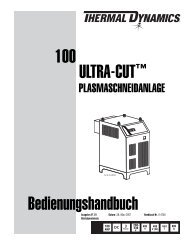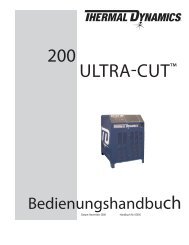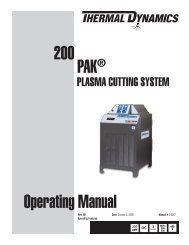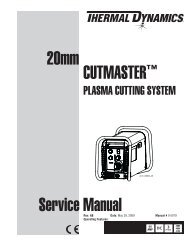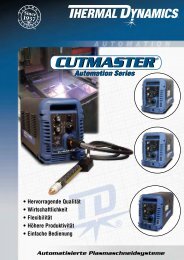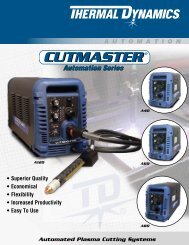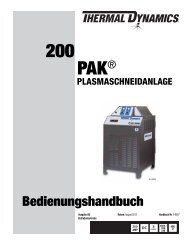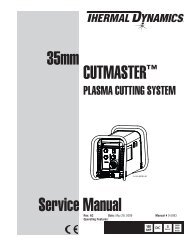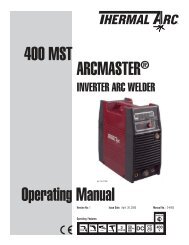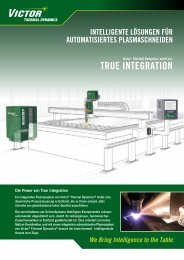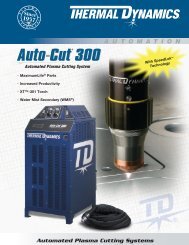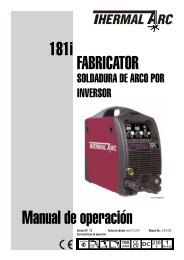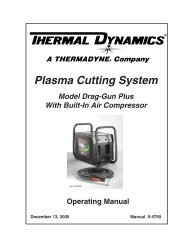211i Operating Manual FabricatOr® - Victor Technologies - Europe
211i Operating Manual FabricatOr® - Victor Technologies - Europe
211i Operating Manual FabricatOr® - Victor Technologies - Europe
You also want an ePaper? Increase the reach of your titles
YUMPU automatically turns print PDFs into web optimized ePapers that Google loves.
FABRICATOR <strong>211i</strong> SAFETY INSTRUCTIONS<br />
5. Use only correct shielding gas cylinders,<br />
regulators, hoses, and fittings designed for the<br />
specific application; maintain them and associated<br />
parts in good condition.<br />
6. Turn face away from valve outlet when opening<br />
cylinder valve.<br />
7. Keep protective cap in place over valve except<br />
when cylinder is in use or connected for use.<br />
8. Read and follow instructions on compressed<br />
gas cylinders, associated equipment, and CGA<br />
publication P-1 listed in Safety Standards.<br />
! WARNING<br />
Engines can be dangerous.<br />
WARNING<br />
ENGINE EXHAUST GASES can kill.<br />
Engines produce harmful exhaust gases.<br />
1. Use equipment outside in open, well-ventilated<br />
areas.<br />
2. If used in a closed area, vent engine exhaust<br />
outside and away from any building air intakes.<br />
WARNING<br />
ENGINE FUEL can cause fire or explosion.<br />
Engine fuel is highly flammable.<br />
1. Stop engine before checking or adding fuel.<br />
2. Do not add fuel while smoking or if unit is near<br />
any sparks or open flames.<br />
3. Allow engine to cool before fuelling. If possible,<br />
check and add fuel to cold engine before beginning<br />
job.<br />
4. Do not overfill tank — allow room for fuel to<br />
expand.<br />
5. Do not spill fuel. If fuelling is spilled, clean up<br />
before starting engine.<br />
WARNING<br />
MOVING PARTS can cause injury.<br />
Moving parts, such as fans, rotors, and belts can cut<br />
fingers and hands and catch loose clothing.<br />
1. Keep all doors, panels, covers, and guards<br />
closed and securely in place.<br />
2. Stop engine before installing or connecting<br />
unit.<br />
3. Have only qualified people remove guards or<br />
covers for maintenance and troubleshooting<br />
as necessary.<br />
4. To prevent accidental starting during servicing,<br />
disconnect negative (-) battery cable from<br />
battery.<br />
5. Keep hands, hair, loose clothing, and tools<br />
away from moving parts.<br />
6. Reinstall panels or guards and close doors<br />
when servicing is finished and before starting<br />
engine.<br />
WARNING<br />
SPARKS can cause BATTERY GASES TO<br />
EXPLODE; BATTERY ACID can burn eyes<br />
and skin.<br />
Batteries contain acid and generate explosive gases.<br />
1. Always wear a face shield when working on a<br />
battery.<br />
2. Stop engine before disconnecting or connecting<br />
battery cables.<br />
3. Do not allow tools to cause sparks when working<br />
on a battery.<br />
4. Do not use welder to charge batteries or jump start<br />
vehicles.<br />
5. Observe correct polarity (+ and –) on batteries.<br />
WARNING<br />
STEAM AND PRESSURIZED HOT<br />
COOLANT can burn face, eyes, and skin.<br />
The coolant in the radiator can be very hot<br />
and under pressure.<br />
1. Do not remove radiator cap when engine is hot.<br />
Allow engine to cool.<br />
2. Wear gloves and put a rag over cap area when<br />
removing cap.<br />
3. Allow pressure to escape before completely<br />
removing cap.<br />
SAFETY INSTRUCTIONS AND WARNINGS 1-4 <strong>Manual</strong> 0-5225



